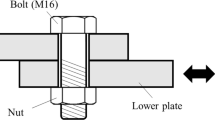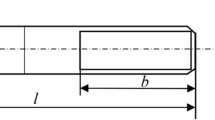Abstract
Various deterministic and uncertain factors are widely present in mechanical equipment and their working conditions. Attenuation of the contact stiffness of bolted joints caused by bolt loosening will directly affect the dynamic characteristics of the joint surface and the working state of the equipment. This paper proposes a contact stiffness attenuation model that considers time-varying uncertainty of the bolt pre-tightening force as a theoretical basis for designing the initial bolt pre-tightening force and secondary tightening strategies. First, the microscopic contact mechanism of the bolted joint surface was revealed, and then a joint contact load and contact stiffness model based on Hertz contact theory and fractal theory was established. A nonlinear mechanical model of the bolted contact surface was obtained. Considering the decrease in bolt pre-tightening force during service, a contact stiffness attenuation law for bolted joints is explored, and a model of the connection reliability of group bolt joints with time-varying uncertainty is established. The bolt pre-tightening force of a railway locomotive was taken as an example and the connection reliability of group bolt structures was predicted, and it is defined that the bolted structure fails when the contact stiffness drops to 80% of the initial value, and the reliability of the group bolts will drop sharply on the 15th day after service, and will almost completely fail on the 22nd day. The proposed theory improves the accuracy of contact modeling and provides a new direction for bolt tightening strategies.











Similar content being viewed by others
Data Availability
The authors declare that all date and material support their published claims and comply with field standards.
References
Zhang ZL, Cheng Q, Qi BB, Tao ZQ (2021) A general approach for the machining quality evaluation of S-shaped specimen based on POS-SQP algorithm and Monte Carlo method. Journal of Manufacturing Systems 60:553–568. https://doi.org/10.1016/j.jmsy.2021.07.020
Cheng Q, Qi BB, Liu ZF, Zhang CX, Xue DY (2019) An accuracy degradation analysis of ball screw mechanism considering time-varying motion and loading working conditions. Mechanism and Machine Theory 134:1–23. https://doi.org/10.1016/j.mechmachtheory.2018.12.024
Niu P, Cheng Q, Liu ZF, Chu HY (2021) A machining accuracy improvement approach for a horizontal machining center based on analysis of geometric error characteristics. International Journal of Advanced Manufacturing Technolog 112:2873–2887. https://doi.org/10.1007/s00170-020-06565-3
Jin TT, Yan CL, Chen CH et al (2021) New domain adaptation method in shallow and deep layers of the CNN for bearing fault diagnosis under different working conditions. International Journal of Advanced Manufacturing Technology 2021:1–12. https://doi.org/10.1007/s00170-021-07385-9
Greenwood J, Williamson J (1996) Contact of nominally flat surfaces. Proceedings of the Royal Society of London 295(1442):300–319. https://doi.org/10.1098/rspa.1966.0242
Guo X, Ma BB, Zhu YC (2017) A magnification-based multi-asperity (MBMA) model of rough contact where the Greenwood-Williamson and Persson theories meet. https://xueshu.baidu.com/usercenter/paper/show?paperid=66d3e221c923c3c8f273e247d67ade27&site=xueshu_se&hitarticle=1
Wang W, Wu J, Gao Z et al (2018) A calculation model for tangential contact damping of machine joint interfaces. Chinese Journal of Theoretical and Applied Mechanics 50(003):633–642. https://doi.org/10.6052/0459-1879-17-425
Hu ST, Huang WF, Shi X, Peng ZK, Liu XF (2019) Review on mechanical seals using a bi-Gaussian stratified surface theory. Journal of Mechanical Engineering 55(01):103–117. https://doi.org/10.3901/JME.2019.01.091
Persson B (2007) Theory of rubber friction and contact mechanics. Journal of Chemical Physics 115(8):3840–3861. https://doi.org/10.1063/1.1388626
Zhao YS, Xu JJ, Cai LG et al (2016) Stiffness and damping model of bolted joint based on the modified three-dimensional fractal topography. ARCHIVE Proceedings of the Institution of Mechanical Engineers Part C Journal of Mechanical Engineering Science 1989-1996:203–210. https://doi.org/10.1177/0954406216631577
Yuan Y, Chen J, Zhang L (2018)Loading-unloading contact model between three-dimensional fractal rough surfaces. Aip Advances 8(7). https://doi.org/10.1063/1.5027437
Liang A, Bian Y, Chen Q et al (2019) Fractal prediction model for the contact of friction surface and simulation analysis. 2019 8th International Conference on Industrial Technology and Management (ICITM):189–195. https://doi.org/10.1109/ICITM.2019.8710745
Liu Z, Jiang K, Zhang C et al (2020) A stiffness model of a joint surface with inclination based on fractal theory. Precision Engineering-Journal of the International Societies for Precision Engineering and Nanotechnology 62:47–61. https://doi.org/10.1016/j.precisioneng.2019.10.012
Ibrahim R, Pettit C (2005) Uncertainties and dynamic problems of bolted joints and other fasteners. Journal of Sound and Vibration 279(3-5):857–936. https://doi.org/10.1016/j.jsv.2003.11.064
Langer P, Sepahvand K, Guist C et al (2017) Finite element modeling for structural dynamic analysis of bolted joints under uncertainty. Procedia Engineering 199:954–959. https://doi.org/10.1016/j.proeng.2017.09.199
Jalali H, Khodaparast H, Madinei H, Friswell MI (2019) Stochastic modelling and updating of a joint contact interface. Mechanical Systems and Signal Processing 129:645–658. https://doi.org/10.1016/j.ymssp.2019.04.003
Mandal B, Chakraborty S, Chakrabarti A (2019) A hybrid approach for global sensitivity analysis of FRP composite multi-bolt joints. Composite Structure 208:189–199. https://doi.org/10.1016/j.compstruct.2018.09.085
Askri R, Bois C, Wargnier H et al (2018) Tolerance synthesis of fastened metal-composite joints based on probabilistic and worst-case approaches. Computer-Aided Design 100:39–51. https://doi.org/10.1016/j.cad.2018.02.008
Qiao S, Pilipchuk V, Ibrahim R (2001) Modeling and simulation of elastic structures with parameter uncertainties and relaxation of joints. Journal of Vibration and Acoustics 123(1):45–52. https://doi.org/10.1115/1.1325409
Jiang W, Wang Z, An L (2016) The uncertainty of bolted joint slippage effects on the inner force of lattice transmission towers. Structural Engineers 32(4):42–50
Guo Q, Zhang L (2005) Identification of the mechanical joint parameters with model uncertainty. Chinese journal of aeronautics 18(1):47-52. JournalArticle/5aee8f5 3c095d710d417bc9a
Qin QZ, Guo QT, Zhan M, Ma H (2019) Finite element model validation of bolted connection structure basing thin layer element method. Structure & Environment Engineering 46(6):41-50. CNKI:SUN:QDHJ.0.2019-06-007
Li K, Zeng J, Yu M (2020) Analysis of frequency response function of flanged cylindrical shell structure considering stiffness uncertainty of bolted connection. Journal of vibration engineering 2020(3):517–524
Liu ZF, Jiang K, Dong XM et al (2020) A research method of bearing coefficient in fasteners based on the fractal and Florida theory [J]. Tribology International 152:106544. https://doi.org/10.1016/j.triboint.2020.106544
Zhao YS, Yang C, Cai LG, Shi WM, Hong Y (2015) Stiffness and damping model of bolted joint with uneven surface contact pressure distribution. Journal of Mechanical Engineering. https://doi.org/10.5545/sv-jme.2016.3410
Zhang X, Wang N, Lan G et al (2014) Tangential damping and its dissipation factor models of joint interfaces based on fractal theory with simulations. Journal of Tribology 136(1):011704
Majumdar A, Bhushan B (1990) Role of fractal geometry in roughness characterization and contact mechanics of surfaces. Trans Asme J Tribology 112(2):205–216. https://doi.org/10.1115/1.2920243
Taiyuan. (2000) Fractal model of the normal contact stiffness of machine joint surfaces based on the fractal contact theory. China mechanical engineering. https://xueshu.baidu.com/usercenter/paper/show?paperid=4a84fb17d01b1df82fb056ae9e10a3a1&site=xueshu_se&hitarticle=1
Wang SX, He JL, Li GF, Hao QB, Huang H (2021) Compilation method of CNC lathe cutting force spectrum based on kernel density estimation of G-SCE. The International Journal of Advanced Manufacturing Technology 2021:1–12. https://doi.org/10.1007/s00170-021-07541-1
Zhao Y, Wang L, Wu H, Chu HY, Liu ZF (2021) Time carying reliability method based on linearized nataf transform. Quality and Reliability Engineering 12. https://doi.org/10.1002/qre.2836
Shi BQ, Shen YH (2018) Mechanical time-varying uncertainty design. China
Zhen H, Li HF, Du XP et al (2013)Simulation-based time-dependent reliability analysis for composite hydrokinetic turbine blades. Structural & Multidisciplinary Optimization 47(5):765–781. https://doi.org/10.1007/s00158-012-0839-8
Huang XD, Miao XM (2014) A complete contact model of a fractal rough surface. Wear: an International Journal on the Science and Technology of Friction, Lubrication and Wear 309:146–151. https://doi.org/10.1016/j.wear.2013.10.014
Gong CQ, Frangopol DM (2019) An efficient time-dependent reliability method. Structural Safety 81:101864.1–101864.7. https://doi.org/10.1016/j.strusafe.2019.05.001
Code availability
Not applicable.
Funding
The author(s) disclosed receipt of the following financial support for the research, authorship, and/or publication of this article. This work was supported by the National Natural Science Foundation of China (52075012)
Author information
Authors and Affiliations
Contributions
All the authors on this list contributed to this article.
Ethics declarations
Competing interests
The authors declared no competing interests.
Additional information
Publisher’s note
Springer Nature remains neutral with regard to jurisdictional claims in published maps and institutional affiliations.
Rights and permissions
About this article
Cite this article
Nana, N., Yongsheng, Z., Congbin, Y. et al. Contact stiffness attenuation model of bolted joint based on time-varying uncertainty. Int J Adv Manuf Technol 124, 3847–3856 (2023). https://doi.org/10.1007/s00170-021-07957-9
Received:
Accepted:
Published:
Issue Date:
DOI: https://doi.org/10.1007/s00170-021-07957-9




